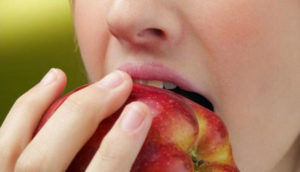Oral allergy syndrome (OAS) is also known as pollen-food allergy syndrome. It is due to cross-reactivity between certain pollens and certain raw fruits and raw vegetables, spices, and nuts. The proteins found in these foods are similar to the proteins found in pollen.  Exposure to these food proteins in patients that have pollen allergy may confuse the immune system causing itching and swelling of lips, mouth, tongue, throat, and face. These symptoms usually occur immediately after eating a raw fruit or vegetable and usually subside quickly as the particular food is either swallowed or removed from the mouth. Severe life-threatening allergic reactions from this are very rare.
Exposure to these food proteins in patients that have pollen allergy may confuse the immune system causing itching and swelling of lips, mouth, tongue, throat, and face. These symptoms usually occur immediately after eating a raw fruit or vegetable and usually subside quickly as the particular food is either swallowed or removed from the mouth. Severe life-threatening allergic reactions from this are very rare.
Who can get OAS?
It is more common in older children and adults. Not all patients with allergic rhinitis develop OAS, but all patients with OAS have an underlying pollen allergy.
What are the common causes of OAS?
Only foods that come from plants can cause OAS. Foods, such as, dairy, seafood, or meats do not cause OAS.
Those with oral allergy syndrome typically have allergy to birch, ragweed, or grass pollens. In fact, 50 to 75% of adults allergic to birch tree pollen develop symptoms of OAS.
Birch Tree Pollen: This is a common tree pollen, pollinating in the springtime. If you are allergic to birch tree pollen, you might also experience OAS symptoms when you eat apples, apricots, cherries, peaches, pears, plums, kiwi, carrots, celery, parsley, legumes (such as peanuts, soybean) and tree nuts (such as almond and hazelnut).
Northern Grass Pollen: Some of the common northern grasses include timothy, orchard, rye, fescue, and bluegrass. They pollinate in the summer. If you are allergic to these grasses, you may experience OAS symptoms when eating peaches, melons, tomatoes, oranges, and white potatoes.
Ragweed Pollen: This is a common weed pollen found in the DFW area during the late summer and fall season. If you are allergic to ragweed pollen, you may develop OAS symptoms when eating melons, bananas, cucumbers, zucchini, or white potatoes.
Mugwort Pollen: This is a different weed pollen that is also found in DFW area and pollinates in the fall. If you are allergic to this pollen, you may experience OAS symptoms when eating bell peppers, broccoli, cabbage, cauliflower, chard, garlic, onions, parsley, and spices, such as aniseed, caraway, coriander, fennel and black pepper.
Diagnosis and Treatment
It is important to distinguish between OAS and severe life threatening food allergy. For this reason, it is important to see a board-certified allergist. Proper diagnosis of OAS involves a thorough history, exam and allergy testing to pollens and to foods. Depending on the individual patient case, further testing with the fresh fruit or raw vegetable may be warranted.
The treatment for OAS is to avoid the foods, in their raw forms, that cause symptoms.
The good news – individuals with OAS can usually eat the same fruits or vegetables in a cooked, baked, or canned form because the proteins are denatured during the heating process and the immune system no longer recognizes the food as immunogenic. Peeling the food before eating it may be helpful as well, since some of the offending protein is concentrated in the skin.
Long term data on OAS is unknown, but some studies show that treating the underlying pollen allergy with immunotherapy may eventually help the OAS symptoms as well.
What’s the next step?
If you experience oral symptoms after eating, particularly in a certain season, you might be experiencing OAS. Come see one of our board-certified allergists at North Texas Allergy & Asthma Center for evaluation, testing, and proper management. We specialize in both allergy and immunology for infants, children, and adults.
SHIKHA MANE, MD
Board Certified Allergist







